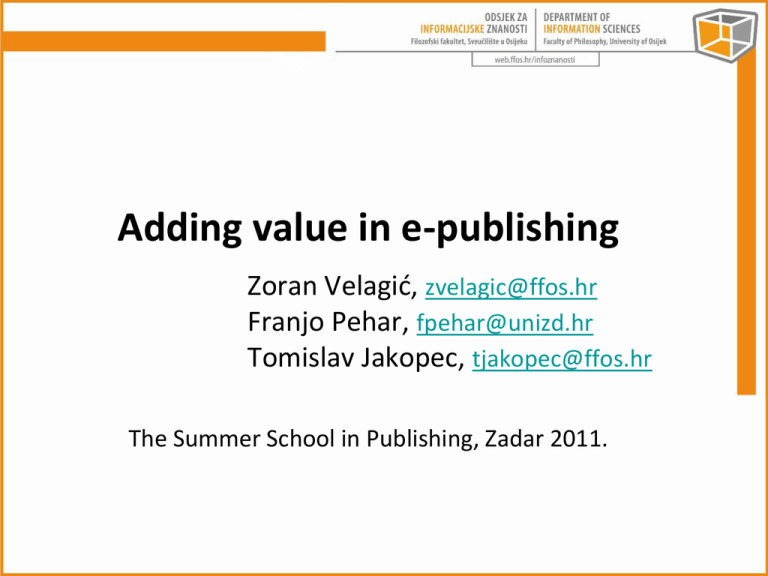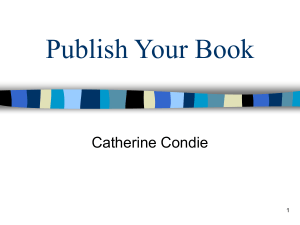What is an “e
advertisement

Adding value in e-publishing Zoran Velagić, zvelagic@ffos.hr Franjo Pehar, fpehar@unizd.hr Tomislav Jakopec, tjakopec@ffos.hr The Summer School in Publishing, Zadar 2011. • Two questions raised by Armstrong and Lonsdale in The publishing of electronic scholarly monographs and textbooks, 1998. (http://www.ukoln.ac.uk/dlis/models/studies/elec-pub/elec-pub.htm): • How value may be added to existing print books through the electronic medium • How value can be added to electronic works in more innovative ways • Otherwise, electronic documents are shrunk to facsimiles of paper originals • advantages of book in printed volume (Giles Clark, Inside Book Publishing (London and New York: Routledge 20023): 2): length, permanence, portability, robustness, browsability, rereadability… physical attractiveness, status in society no need for power source or maintenance, transcends technological changes portability – physical attractiveness + transcends technological changes – development of e-readers inner & outer aesthetic only in short terms • What is a book? • Unesco definition • “a collection of pages containing text and sometimes pictures, bound together inside a cover” (the guardian’s Dictionary of Publishing and Printing, A&C Black, 20063) • “primitive” information architecture (Cope and Philips) • means (agent) of communication (Darnton) • … • intrinsically characterized by market/cultural dichotomy There is no single and simple answer in book history, publishing history, book studies, media studies … = we speak different languages • advantages of book as electronic work (from Thompson, J. B. Books in the Digital Age… (Cambridge: Polity Press, 2005) onward): • browsability, accessibility • unlimited content (+ ∞) • simple intervention (correction, replenishment…) • “over” time and space • hyperlinks, multimedia • … • the content of e-book is “more relaxed” regarding platform (M. Kovač) browsability – unlimited content vs. length ? “over” time and space – only from contemporary perspective: red thread content – platform issue (eg. Kovač) – again contemporary perspective • What is an “e-book”? • “a battery-powered portable reading device displaying text on a high-resolution screen” (the guardian’s Dictionary of Publishing and Printing, A&C Black, 20063) • e-book reader – a piece of software which allows e-books to be read on a PC • “Thought of by most people as an electronic version of a printed book that is downloaded to a reading device, e-books are any type of book that can be read in electronic format, frequently with a variety of interactive digital features (searching, bookmarking, note-taking) and multimedia enhancements. E-book (the electronic content) should not be confused with e-book reading systems or devices.” (The Columbia Guide to Digital Publishing (New York: Columbia University Press, 2003) There is no single and simple answer … = we speak different languages • Book and “e-book” as mass-media products the rise of international media conglomerates + blockbuster culture + tie-ins + (IT) globalization + … = concept of a book as a mass-media product • “Masovne medije razlikujemo prema vrsti ili sektoru (knjiga, tisak (novine, časopisi), film, televizija, radio, nosači zvuka i slike (video, CD, DVD)…” (Peruško, Z. ed. Uvod u medije. (Zagreb: Jesenski i Turk etc., 2011): 16). • Publishing industry is facing the destiny of the music industry (eg. Jeff Gomez): printed books will be replaced by digital files the same as MP3 files replaced CDs. Motif for purchasing? Entertainment? • does Book exist? • the concept of publishing fields? What is media and what is transfer technology? • is printed book comparable with audio CD? • Book and “e-book” as information • content as such (= text, discourse, ŠTIVO) is often replaced with “information”: “’information’ was taken to denote not the instruction derived from books, but the content of books from which instruction is derived … This … is exactly what contemporaries did in creating the new sense of the word”(Geoffrey Nunberg, „Farewell to the information age“. In The Book History Reader, ed. David Finkelstein and Alistair Mc Cleery, 509 – 525. (London – New York: Routledge, 2002.): 515. Essay form 1996.) • ‘information’ changed from effect to cause • in extremes, leads towards supersession and liberation theories: fixed page as a prison of information – freedom to access information becomes freedom of information – and new technology liberates information from chains of printed book (Paul Duguid, „Material Matters. The Past and Futurology of the Book“) • contaminated term (freedom of information…) • different texts: carriers of meaning (informational) & creative events (aesthetic); linguistic and bibliographic codes within texts (Jerome McGann, „The socialization of texts“) • book is neither Book, nor mass-media product, nor information • each concept comes from narrow perspective, authors are necessary hostages of their own perspectives • concepts must not be taken as universal and worldwide applicable • instead in categories of Book, one should think in categories of publishing fields (Pierre Bourdieau, J. B. Thompson) • instead in categories of liberation one should think in categories of intrinsic (technical) development inside publishing industry • instead in categories of supersession one should think in categories of diversity of publishing industry • coffe table books, cutout books, reference books, STM books … • possibilities of adding value in five interconnected fields (according to Paul Richardson and Graham Taylor, A Guide to the UK Publishing Industry. (The Publishers Association, 2008.)): • economic – profitable industry, highly-skilled people, involved in technological development • educational – school system is almost completely based on publishers’ products • scientific – enables scientific communication, access to information and knowledge • social (entertainment) – socialization of child, free time of adults… • cultural – publishing diversity as necessity for vital democracy, soft diplomacy … MARKET – READERS CONTENT, TEXT, ŠTIVO INFORMATIONAL, AESTHETIC … CONTENT ECONOMIC EDUCATIONAL SCIENTIFIC SOCIAL CULTURAL … FIELDS PUBLISHING FIELDS EDITING, TRANSFER, MANIPULATION… TECHNOLOGY http://web.ffos.hr/oziz/novosti/


